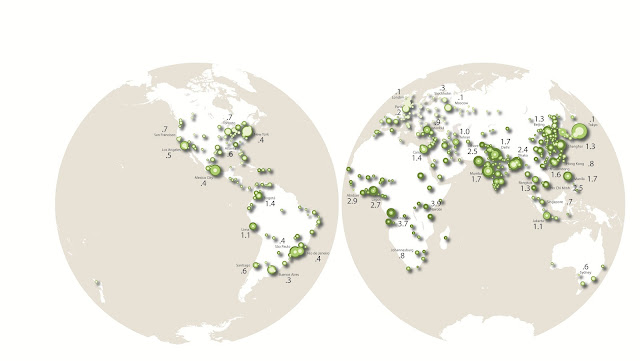Brad Plumer listed a number of reasons that can be summarized into: lack of trees and plants in the city to clean up urban air; building materials not adapted to temperature rising; human activities; and automobiles (both should be put at top of this list). Brad Stone, a researcher of Georgia Institute of Technologies, writes in a paper published in the journal Landscape and Research Planning:
It's not surprising that cities are heating up more rapidly than surrounding areas. But the extent to which they're amplifying warming trends did come as a surprise. [Originally quoted in Brad Plumer, The Washington Post, 2012]
What this article shows up is a call for a new approach to planning cities that includes new building materials. As temperature is rising, this will lead to serious public health issue, accordingly.
Lack of trees and plants in most cities. Cities have been dominated by red, grey and brown. Green is translated into small-scaled parks, even pocket parks in crowded cities that face a lack of space like Tokyo. According to observers, cities must reconsider zoning laws for more place for green features. Borough President Marty Markowitz, for example, argues:
Here in New York, we don't have acres and acres of land to grow fresh food, and that's why I've been advocating for the changing of zoning laws to maximize rooftop space and open up our borough's industrial buildings for growing fresh produce. [Quoted by Molly Cotter, Inhabitat]
Allow me for mentioning an example. Paris counts 450 green areas including woodlands, parks, communal gardens, and promenades. Paris recently announced the implantation of a linear urban forest that will link Porte de la Villette and Porte de la Chapelle. It is announced that the aim of this new feature is not only to clean up Paris's air as well as to serve as a promenade for users and habitat for wildlife, plants and animals. Paris is neither the first nor the only city that envisions the plantation of an urban forest: Portland, Milan are the others cities and the list will certainly grow up. As known — and this may explain this increasingly number of green projects — green areas improve air quality within urban areas.
 |
| UN Population Division (2011). World Urbanization Prospects: The 2009 Revision Population Database. Originally appeared on Dynamics of Urbanisation | Antoine Paccoud/LSE Cities/Urban Age |
Related:
But this leads to a crucial question: Urban heat waves may cause serious public health issues. As Brad Plumer reported, between 1979 and 2003, heat waves killed at least 8,0195 Americans. And I don't mention the 2003 heat waves that hit France which death tolls rose to above 15,000. Now that — needless to say — we are in an urban age, cities must put focuses on urban heat and its consequences on citizens' health, well-being and quality of life, and ecosystems. Hence this question: are cities prepared to future heat waves? No. And while we are envisioning cities more sustainable, one must admit that, as Anna Leidreiter writes, sustainable cities is too nebulous and vague. According to the same Anna Leidreiter, a regenerative city may be a solution to adapt to future pressures. It consists of redressing:
[T]he relationship between cities and their hinterland, and beyond that with the more distant territories that supply them with water, food, timber and other vital resources. We need to re-enrich the landscapes on which cities depend, including measures to increase their capacity to absorb carbon.
Suggested article: Anna Leidreiter | Sustainable is not enough: a call for regenerative cities || The Global Urbanist
 |
| Urban Climate Trends | Urban Climate Lab || Georgia Institute of Technology, 2012 |
However facts are put on the table that need to be taken seriously and rapidly as urban migration will continue to grow up along with internal and external constraints. Building materials also need to be urgently reconsidered. As many researchers have observed, existing building materials contribute to urban heat effect with a serious impact on citizens' health and well-being as well as biodiversity.
Source
Brad Plumer | Study: Many U.S. cities unprepared for future heat waves || Washington Post, July 26, 2012
Brian Stone Jr | Urban and rural temperature trends in proximity to large US Cities: 1951-2000 || Georgia Institute of Technology
Brian Stone, Jason Vargo, Dana Habeeb | Managing climate change in cities: Will climate action plans work?, 2012
Centers for Disease Control and Prevention | Extreme heat: A prevention guide to promote your personal health and safety
In French: Villes et adaptation au changement climatique ı Rapport au Premier ministre et au Parlement
Antoine Paccoud | Dynamics of Urbanisation | Cities, Health, Well-Being ı Hong Kong Conference, 2011
Antoine Paccoud | Measuring the Human Urban Footprint | Cities, Health, Well-Being ı Hong Kong Conference
Anna Leidreiter | Sustainable is not enough: a call for regenerative cities || The Global Urbanist


No comments:
Post a Comment